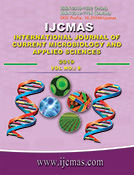


 National Academy of Agricultural Sciences (NAAS)
National Academy of Agricultural Sciences (NAAS)

|
PRINT ISSN : 2319-7692
Online ISSN : 2319-7706 Issues : 12 per year Publisher : Excellent Publishers Email : editorijcmas@gmail.com / submit@ijcmas.com Editor-in-chief: Dr.M.Prakash Index Copernicus ICV 2018: 95.39 NAAS RATING 2020: 5.38 |
Precipitation records often suffer from missing data values for certain time periods due to various reasons, one of them being the malfunctioning of rain gauges. This is an important issue in practical hydrology as it affects the continuity of rainfall data. The missing data values ultimately influence the results of hydrologic studies that use rainfall data as one of the input variables. Therefore, it is crucial to estimate the missing rainfall data for qualitative hydrologic assessment. In this study, the annual rainfall data of eight districts of the state Madhya Pradesh, India is collected in the time frame of the year 1901 to 2011. The collected information is used for estimating missing annual rainfall data. Various existing standard models, such as arithmetic mean, normal ratio, inverse distance weighting, multiple linear regression as well as unconventional methods like artificial neural network (ANN) is used and compared to determine missing rainfall records in the collected data. The results as obtained show that among the various standard models, multiple linear regression models perform better. The model is validated and the correlation coefficient (R), root mean square error (RMSE) and mean absolute error (MAE) are found to be 0.913, 9017 mm, and 49.7 mm, respectively. When the ANN model is applied for estimating annual missing rainfall data, it is found that Levenverg Marquardt (lm) algorithm with 7 neurons and 50-year length of records performs better than the other combination of algorithms, neurons and length of records. During the training of this model, the values of R, RMSE and MAE value are found to be 0.998, 4.4x10-4 mm and 53.047 mm, respectively, and during validation, they are 0.858, 1.667 mm and 49.103 mm, respectively. The results as obtained indicate that the ANN method is most suitable for estimating the missing annual rainfall data.
 |
 |
 |
 |
 |